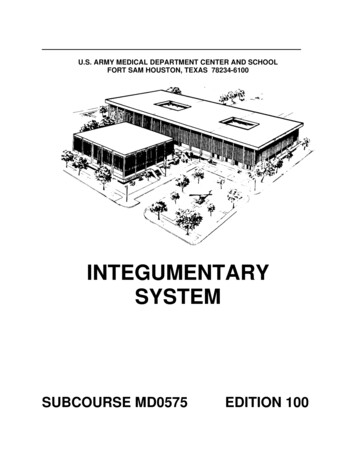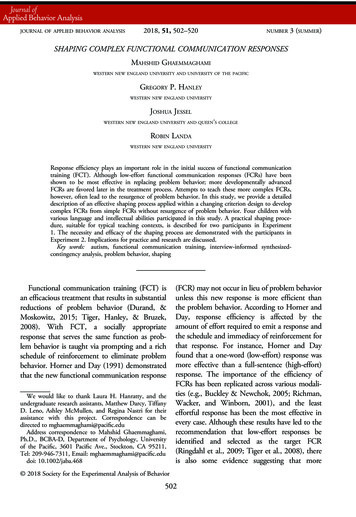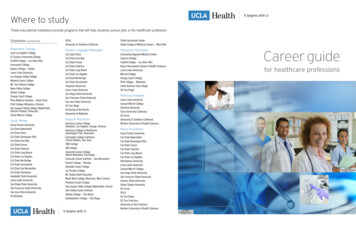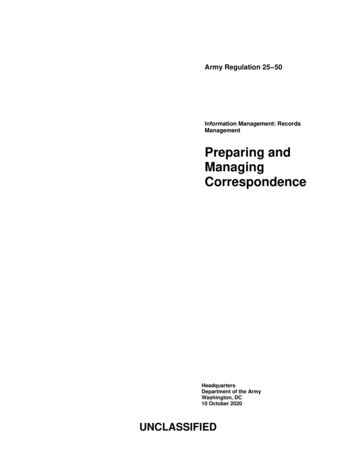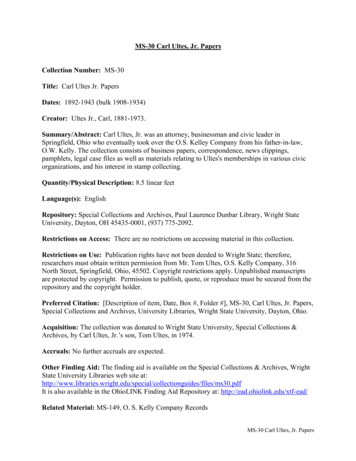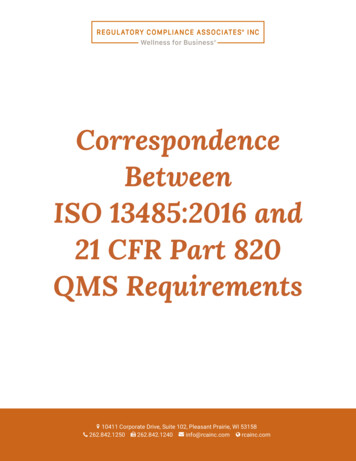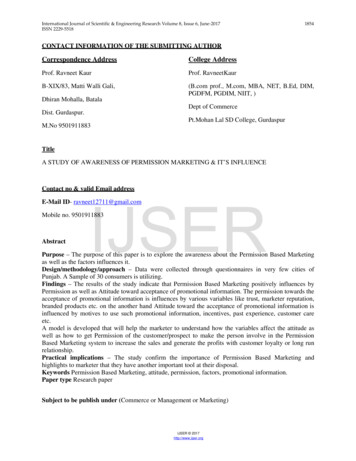
Transcription
International Journal of Scientific & Engineering Research Volume 8, Issue 6, June-2017ISSN 2229-55181854CONTACT INFORMATION OF THE SUBMITTING AUTHORCorrespondence AddressCollege AddressProf. Ravneet KaurProf. RavneetKaurB-XIX/83, Matti Walli Gali,(B.com prof., M.com, MBA, NET, B.Ed, DIM,PGDFM, PGDIM, NIIT, )Dhiran Mohalla, BatalaDept of CommerceDist. Gurdaspur.Pt.Mohan Lal SD College, GurdaspurM.No 9501911883TitleA STUDY OF AWARENESS OF PERMISSION MARKETING & IT’S INFLUENCEContact no & valid Email addressIJSERE-Mail ID- ravneet12711@gmail.comMobile no. 9501911883AbstractPurpose – The purpose of this paper is to explore the awareness about the Permission Based Marketingas well as the factors influences it.Design/methodology/approach – Data were collected through questionnaires in very few cities ofPunjab. A Sample of 30 consumers is utilizing.Findings – The results of the study indicate that Permission Based Marketing positively influences byPermission as well as Attitude toward acceptance of promotional information. The permission towards theacceptance of promotional information is influences by various variables like trust, marketer reputation,branded products etc. on the another hand Attitude toward the acceptance of promotional information isinfluenced by motives to use such promotional information, incentives, past experience, customer careetc.A model is developed that will help the marketer to understand how the variables affect the attitude aswell as how to get Permission of the customer/prospect to make the person involve in the PermissionBased Marketing system to increase the sales and generate the profits with customer loyalty or long runrelationship.Practical implications – The study confirm the importance of Permission Based Marketing andhighlights to marketer that they have another important tool at their disposal.Keywords Permission Based Marketing, attitude, permission, factors, promotional information.Paper type Research paperSubject to be publish under (Commerce or Management or Marketing)IJSER 2017http://www.ijser.org
International Journal of Scientific & Engineering Research Volume 8, Issue 6, June-2017ISSN 2229-55181855A STUDY OF AWARENESS OFPERMISSION MARKETING & IT’SINFLUENCEABSTRACTPurpose – The purpose of this paper is to explore the awareness about the Permission BasedMarketing as well as the factors influences it.Design/methodology/approach – Data were collected through questionnaires in very few citiesof Punjab. A Sample of 30 consumers is utilizing.Findings – The results of the study indicate that Permission Based Marketing positivelyinfluences by Permission and Attitude toward acceptance of promotional information.Practical implications – The study confirm the importance of Permission Based Marketing andIJSERhighlights to marketer thatthey have another important tool at their disposal.Keywords Permission Based MarketingPaper type Research paperINTRODUCTION: Traditionally mass marketing and interruption marketing are applied asmarketing strategies. These marketing strategies interrupt the customer in their activities. Theconcept of permission marketing overcomes this problem. Seth Godin is the person who foundedthe first company in the world to put promotional campaigns through internet, turned the sameinto the online permission marketing pioneer. Permission Marketing and Seth Godin havebecome synonyms of each other. He introduce the term permission marketing in his book –“Permission Marketing: Turning Strangers into Friend and Friend into Customers” (1999). Healso focuses on quality of the advertisement messages, adoption of which is happily acceptableby the customers. The permission marketing is useful for small as well as large companies. Inmodern era of Permission marketing, customer consider the marketing communication as theyhave opted to be marketed and rewarded with payment or other benefits for going throughmarketing messages. But the marketing messages should not interrupt the customers. On the oneside permission marketing makes the advertisement effective and on another side it helps themarketers to create and maintain long-term interactive relationship with the customers.IJSER 2017http://www.ijser.org
International Journal of Scientific & Engineering Research Volume 8, Issue 6, June-2017ISSN 2229-55181856However, certain questions arise:1. What is permission?2. Why permission require?3. Are consumers willing to give permission/personal information?4. What factors affect the consumer permission?1. WHAT IS PERMISSION?The term “Permission” means the formal action of allowing someone to do a particular thing. InMarketing, permission is express, verifiable consent/authorisation to receive marketingcommunication. When an organization collects personal information from an individual, mostprivacy legislation is required. An individual’s consent be given so that an organization cancollect, use, or disclose it. However, there are sometimes exceptions to this rule. There are threedifferent types of permission/consent a marketer may obtain i.e. Explicit Permission/Consent,IJSERImplicit Permission/Consent and Opt-out Permission/Consent. Explicit Permission/Consentrefers to a contact where person has given explicit permission through electronic messages.Contacts can opt-in through an online or physical signup form, over the phone, at the point ofsale or by responding to a coupon offer or contest. Implicit Permission/Consent is also knownas indirect consent. It mean one provides personal information voluntarily for an organization tocollect, use, or disclose for purposes that would be considered obvious at the time, or providespersonal information to an organization and it is used in a way that clearly benefits you and theorganization’s expectations are reasonable. Opt-out Permission/consent isalso known as givingconsent by not declining to give consent — means that an individual is given the option todecline consent. If the individual does not clearly decline consent, consent is granted. Opt-outconsent is usually done in writing.2. WHY PERMISSION REQUIRE?Unsolicited advertisements may lead to consumers’ frustration and unanticipated results that isthe reason the permission matters to send promotional information. Even sending promotionalinformation to prospects/consumers without their’ consent is a violation of privacy. If we couldbetter understand what affects consumers’ willingness to give permission, this approach maysolve numbers of sensitive issue. It makes the marketers, managers and advertising companiesIJSER 2017http://www.ijser.org
International Journal of Scientific & Engineering Research Volume 8, Issue 6, June-2017ISSN 2229-55181857not only to build the strategies but also able to offer better services to consumers and increasetheir competitiveness. Consumers will benefit from tailored/customized services that specificallyanswer their needs and requirements.3. ATION?Why would someone give you permission to market to them? The answer is quite simple:because it’s in his or her best interest to do so! To get permission, give people something theywant. Reward them for opting-in. Rewards can be tangible-things like promotional items, prizes,and other incentives. They can also be intangibles such as free information or special offers.The companies keep customer up-to-date regarding its products & product line. It also savesmoney as well as time of customer to visit the site of the company.Get permission from subscribers who want to receive company’s campaigns is the very first stepIJSERto building a successful list of prospect to send the promotional messages. Marketer has tounderstand what is the importance of permission as well as how to secure it. It is beneficial tomarketer as people expect to hear from you, this will provide to lead you among all othermarketer. It will ensure you more targeted marketing. More customer awareness ensures highersales and profits. Permission market makes the marketer able to use lower cost methodseffectively. It makes testing easy and tracking. It ensures less wasted advertisement, because theadvertisement message will reach to the interested customer only. It also increased customerlifetime value, opportunities for additional sales etc.4. WHAT FACTORS AFFECT THE CONSUMER PERMISSION?A large number of factors affect the consumer permission such as:i.Trust: There is a two kind of trust i.e. Personal Trust and Institution Trust. Both haveimpact on permission based marketing. Personal trust is either combination of personalcommunication with trustee or data acquired from personal sources. On the other handInstitutional trust is the trust of respondent on institutional environment containingpolitical sectors and civil societal organization.ii.Perceived control: Perceived control refers to individual awareness about their abilitiesto execute a known behavior. It was further to the logical achievement in which peoplemay lack volitional control over the manner of interest. It could be covered by belief. Inmobile marketing trust a perceived control have an inverse relationship. However, pc hasIJSER 2017http://www.ijser.org
International Journal of Scientific & Engineering Research Volume 8, Issue 6, June-2017ISSN 2229-55181858influence on permission, as permission required the respondent would give permission incontext of pc because pc is the name of personal ability to do.iii.Privacy Policy: Privacy is defined as “the right of an individual to control theinformation held about them by third parties”. Permission-based marketing is consideredto be the easiest way to tackle the privacy issue (Godin, 1999).iv.Marketer’ reputation:Reputation is also a very important factor in gaining trust.Reputation will also help in building a long-term perspective with consumers Reputationis usually considered as the assessment in which a thing or any person is commonly held,as a name or favorable standing or as the way in which a particular person or thing isknown for. It has been determined the relationship between loyalty and reputation of theorganization. It entails:a) Branded productse) Privacy policyIJSERb) Past experiencesf) Marketer’s commitmentsc) Secured payment systemg) othersd) Quick customer carev.Branded product:When a certain brand has a reputation towards consumers, mobileadvertising concerning that particular brand will have the quality of being reliably true.As a brand has a certain reputation, consumers will feel more secure when giving outtheir personal information. Product brand bring loyalty as well as trust in mind ofconsumer, which leads to give permission to the company to send the promotionalinformation.vi.Regular used items:The items/products which are used on regular basis encourage theconsumer to give permission to send the promotional information.vii.Length:Lengthy informationemboldens the reader to delete message without read,unsubscribe or other which is not liked by the marketer. So the succinct informationencourages the consumer to give their consent.viii.Motives: Motives are the purpose of using promotional information like education,affection, entertainment, up-to-date, save time & efforts, fashion, escape, no disturbance,data reliability and coordination. There would be deferent motives of using thisinformation for an individual. Motives will vary for culture to culture or individual toindividual. Uses and satisfaction theory can be explaining the motives of an individual.IJSER 2017http://www.ijser.org
International Journal of Scientific & Engineering Research Volume 8, Issue 6, June-2017ISSN 2229-55181859Successful symbol of advertising is attitude it is self-evaluation of an individual towardsthe particular product/service. Similarly, attitude toward promotional information couldbe positive because of certain benefits like enjoyment pleasure, acquiring knowledge etc.Motives may be:a) Reliable datad) Interestb) Up-to-date informatione) othersc) Save time and effortsix.Incentives/benefits: Marketer usually offers some incentive—for example, a specialdiscount or a gift to get permission from prospect/customer. Once you obtain this initialpermission, you try to obtain higher levels of permission by offering other rewards. Bygetting additional customer permission and maintaining long run interactive relationship,the marketer can change the habits & behavior of the customers to generate higher profit.x.IJSERPast experience: Customer experience is the product of a contact/relation between anorganization and a customer over the period of their relationship that involved thecustomer journey, the brand loyalty, and the environments the customer experiencesduring their experience.A good customer experience means that the individual'sexperience matches the individual's expectations that leads to the customer loyalty aswell as it build the positive or negative attitude towards the product/service. Customerexperience implies customer involvement at different levels – such as rational, emotional,sensorial, physical, and spiritual.xi.Quick customer care: Customer service/care is the act of taking care of the customer'sneeds by providing and delivering professional, helpful, high quality service andassistance before, during, and after the customer's requirements are met. In other words,the work of looking after customers and ensuring their satisfaction with one's businessand its goods or services is called as customer care. Feeling of satisfaction is also one offactor to build the attitude toward acceptance of promotional information.xii.Secure payment system: Secure payment system creates the assured environment for thecustomer to deal with company. It also forms secure attitude towards the company.xiii.Easy return policy: It is theprocess of a customer taking previously purchasedmerchandise back to the retailer, and in turn receiving a refund in the original form ofpayment, exchange for another item (identical or different), or a store credit.if theIJSER 2017http://www.ijser.org
International Journal of Scientific & Engineering Research Volume 8, Issue 6, June-2017ISSN 2229-55181860customer is assured that his/her product will be accepted back in case of damages, wrongdelivery, poor quality etc., it will change his/her attitude at time of purchase.xiv.Acceptance of permission based marketing: There are number of factors that givemotivation of consumer to give permission like relevant and customize information,financial advantage, demographic factors, massaging cost and privacy issue.xv.Attitude towards acceptance of promotional information: Attitude towardsacceptance of promotional information covers like acceptance, use individual behaviors,demographic effects, authorization, and other perspectives promotional information.Empirical studies show that there is a well-built relationship between the attitude towardacceptance of promotional information and acceptance of Permission based marketing.xvi.Permission towards the acceptance of Promotional Information:Permission isbeginning of two-way communication between the customer and marketer. It is notIJSERpossible to carry out permission based marketing without clear permission from thecustomer.xvii.Others:a) Use of technology: Lack of use of technology, lack of awareness of advantages ofusing technology dampens the person to opt in.b) ragesone-to-onemarketing. In order to reach our desired audience and engage with them in arelevant and timely fashion we have to meet them on their terms. Personalizationis one of the best ways to increase the effectiveness and relevancy of informationc) Frequency of receiving information: Frequency is all about the practice of usinginformation in given period or in other words it means measure of receivinginformation. If marketer understand the using frequency of information ofanindividual it would be easier for him to target a significant market.d) OthersSCOPE OF THE STUDYSample size30 questionnaires were distributed to a conveniently generated sample.All the questionnaires were returned with a response rate of 100 per centType of SamplingIJSER 2017http://www.ijser.org
International Journal of Scientific & Engineering Research Volume 8, Issue 6, June-2017ISSN 2229-55181861The samples were selected through Convenience sampling.Nationality of SampleThe respondents were Indians.RESEARCH METHODOLOGYMethods of Data Collection: It details the procedure necessary for obtaining the informationneeded to structure or solve Marketing research problems. The present study is a descriptiveresearch and involves the use of “Survey Method”. Quantitative data collection will be achievedvia self-administration of the questionnaire. Electronic survey methods, Google forms, are usedas the mode of administration. In electronic method, links were sent to respondents at E-mails,What’s app and Facebook. Internet can be used as a medium to conduct the survey.Questionnaire Development: the questionnaire was structured as follows.The first part of the questionnaire consisted questions used to explore and assess the awarenessIJSERof permission marketing as well as the factors consider by prospect/customer and marketer whilegiving their personal detail and developing the marketer strategies respectivelyThe second part contained questions related to personal information of consumer, who is the partof sample selected for survey. The questionnaire included general demographic questions such asname, designation, age, education, sex, marital status etc.SAMPLING AND DATA COLLECTIONGeneral Profile of ConsumersStatisticsRespondentgenderValid30NMissing 0Respondentdob300RESPONDENT GENDERFrequencyMALE15Valid .050.0100.0Respondentstatus300Valid Percent50.050.0100.0IJSER entcity300Cumulative Percent50.0100.0
International Journal of Scientific & Engineering Research Volume 8, Issue 6, June-2017ISSN 2229-55181862RESPONDENT DOB18-21A22-25Valid 26-29MORE THAN 0RESPONDENT QUALIFICATIONFrequencySENIOR SECONDARY1GRADUATE13Valid POST GRADUATE10PROFESSIONAL DEGREE 6Total30Valid 100.0Cumulative Percent26.760.070.0100.0Valid Percent3.343.333.320.0100.0Cumulative Percent3.346.780.0100.0IJSERRESPONDENT 00.0Valid Percent46.73.33.336.710.0100.0Cumulative Percent46.750.053.390.0100.0RESPONDENT INCOMEUNDER 000 & 10.0100.0Valid Percent40.016.716.716.710.0100.0Cumulative Percent40.056.773.390.0100.0RESPONDENT CITYFrequencyPercentValid PercentIJSER 2017http://www.ijser.orgCumulative Percent
International Journal of Scientific & Engineering Research Volume 8, Issue 6, June-2017ISSN 6370.090.096.7100.0HYPOTHESISAwareness of Permission MarketingH1.1: there is significant relationship between customers’ awareness about Permission Marketingand Gender.One-Sample TestTest Value 0TdfSig.Mean Difference(2tailed)IJSER95% Confidence Interval of theDifferenceLowerUpper2.28493.51519.64 29.0002.900002RESPONDE 16.1 29.0001.5001.311.69NT55GENDERHere the p value is less than 0.05, so the alternative hypothesis is accepted that there isAwarenesssignificant relationship between customers’ awareness about Permission Marketing and Gender.H1.2: there is significant relationship between customers’ awareness about Permission Marketingand Age group.One-Sample TestTest Value 0tdf Sig.(2- Meantailed)DifferenceAwarenessRESPONDENTDOB9.642 29 .00015.745 29 .0002.900003.433IJSER 2017http://www.ijser.org95% Confidence Interval of theDifferenceLowerUpper2.28493.51512.993.88
International Journal of Scientific & Engineering Research Volume 8, Issue 6, June-2017ISSN 2229-55181864Here the p value is less than 0.05, so the alternative hypothesis is accepted that there issignificant relationship between customers’ awareness about Permission Marketing and age.H1.3: there is significant relationship between customers’ awareness about Permission Marketingand Qualification.One-Sample TestTest Value 0tdf Sig. (2- Meantailed)Difference95% Confidence Interval ofthe .642 29 .0002.90000RESPONDENT27.715 29 .0004.667QUALIFICATIONHere the p value is less than 0.05, so the alternative hypothesis is accepted that there isIJSERsignificant relationship between customers’ awareness about Permission Marketing andqualification.H1.4: there is significant relationship between customers’ awareness about Permission Marketingand Employment Status.One sample testTest Value 0tdf Sig.(2- Meantailed)Difference95% Confidence Interval of 2 29 .0002.90000RESPONDENT7.708 29 .0002.800STATUSHere the p value is less than 0.05, so the alternative hypothesis is accepted that there issignificant relationship between customers’ awareness about Permission Marketing and status.H1.5: there is significant relationship between customers’ awareness about Permission Marketingand City of Respondents.One-Sample TestIJSER 2017http://www.ijser.org
International Journal of Scientific & Engineering Research Volume 8, Issue 6, June-2017ISSN 2229-5518Test Value 0tdf Sig.(2- Meantailed)Difference186595% Confidence Interval of ss9.642 29 .0002.90000RESPONDENT10.145 29 .0001.433CITYHere the p value is less than 0.05, so the alternative hypothesis is accepted that there issignificant relationship between customers’ awareness about Permission Marketing and city ofrespondent.H1.6: there is significant relationship between customers’ awareness about Permission Marketingand income.IJSEROne-Sample TestTest Value 0tdfAwarenessRESPONDENTINCOME9.6428.0002929Sig.(2- Meantailed)Difference.000.0002.900002.66795% Confidence Intervalof the DifferenceLowerUpper2.28493.51511.983.35Here the p value is less than 0.05, so the alternative hypothesis is accepted that there issignificant relationship between customers’ awareness about Permission Marketing and incomeof respondent.Acceptance of promotional informationH1.7: There is positive relationship between trust and permission toward acceptance ofpromotional informationOne-Sample TestTest Value 0Tdf Sig. (2- Meantailed)DifferenceAcceptance19.027 29 .00024.06667IJSER 2017http://www.ijser.org95% Confidence Interval ofthe DifferenceLowerUpper21.479826.6536
International Journal of Scientific & Engineering Research Volume 8, Issue 6, June-2017ISSN 2229-55181866what will encourage you?- 7.255 29 .0002.4001.723.08past good experienceHere the p value is less than 0.05, so the alternative hypothesis is accepted that there is positiverelationship between trust and permission toward acceptance of promotional information.H1.8: There is positive relationship between privacy policy and permission toward acceptance ofpromotional information.One-Sample TestTest Value 1tDf Sig. (2- Meantailed)Difference95% Confidence Interval ofthe e18.237 29 .00023.06667what will encourage you?- 6.227 29 .000.967strong privacy policyHere the p value is less than 0.05, so the alternative hypothesis is accepted that there is positiveIJSERrelationship between strong privacy policy and permission toward acceptance of promotionalinformation.H1.9: There is positive relationship between Marketer’s Reputationand permission towardacceptance of promotional information.Marketer’s reputation consist factors like branded products, past experiences, secured paymentsystem, quick customer care, easy return policy, privacy policy, marketer’s commitments etc.One-Sample TestTest Value 1Tdf Sig.tailed)(2- MeanDifference95% Confidence Interval of theDifferenceLowerUpperReputation 14.994 29 .00013.7000011.831315.5687Awareness 6.317 29 .0001.900001.28492.5151Here the p value is less than 0.05, so the alternative hypothesis is accepted that there is positiverelationship between Marketer’s Reputation and permission toward acceptance of promotionalinformationIJSER 2017http://www.ijser.org
International Journal of Scientific & Engineering Research Volume 8, Issue 6, June-2017ISSN 2229-55181867H1.10: There is positive relationship between Branded products/services and permission towardacceptance of promotional information.One-Sample TestTest Value 1TdfMeanDifference95% Confidence Interval of theDifferenceLowerUpperSig.(2tailed)18.237 29 .00023.066675.794 29 randHere the p value is less than 0.05, so the alternative hypothesis is accepted that there is positiverelationship between Branded products/services and permission toward acceptance ofIJSERpromotional information.H1.11: There is positive relationship between products/services regularly used and permissiontoward acceptance of promotional information.One-Sample TestTest Value 1TDf Sig.(2- Meantailed)DifferenceAcceptance18.237 29 .000deals with regular 7.919 29 .000products23.066671.33395% Confidence Interval of theDifferenceLowerUpper20.479825.6536.991.68Here the p value is less than 0.05, so the alternative hypothesis is accepted that there is positiverelationship between products/services regularly used and permission toward acceptance ofpromotional information.H1.12: There is positive relationship between length of messages and attitude toward acceptanceof promotional information.One-Sample TestTest Value 1IJSER 2017http://www.ijser.org
International Journal of Scientific & Engineering Research Volume 8, Issue 6, June-2017ISSN 2229-5518Tdf Sig.tailed)(2- MeanDifference95% ConfidenceDifferenceLower12.4297.901868Interval of theUpper16.10371.50Attitude15.884 29 .00014.26667Brief8.163 29 .0001.200informationThe p value is less than 0.05 so the alternative hypothesis is accepted which means there ispositive relationship between length of messages and attitude toward acceptance of promotionalinformation.H1.13: There is positive relationship between motive for using promotional information andattitude toward acceptance of promotional information.One-Sample TestTest Value 1tdf Sig.tailed)IJSERAttitude 15.884 29 .000Motive 19.992 29 .000(2- MeanDifference14.2666712.1000095% Confidence 3.3379oftheHere the p value is less than 0.05, so the alternative hypothesis is accepted that there is positiverelationship between motive for using promotional information and attitude toward acceptance ofpromotional information.H1.14: There is positive relationship between incentives and benefits received and attitudetoward acceptance of promotional information.One-Sample TestTest Value 1tDf Sig.(2- 84 29 .000good 9.607 29 .00014.266671.433IJSER 2017http://www.ijser.org95% Confidence Interval of theDifferenceLowerUpper12.429716.10371.131.74
International Journal of Scientific & Engineering Research Volume 8, Issue 6, June-2017ISSN 2229-55181869Here the p value is less than 0.05, so the alternative hypothesis is accepted that there is positiverelationship between incentives and benefits received and attitude toward acceptance ofpromotional informationH1.15: There is positive relationship between Past experience and attitude toward acceptance ofpromotional information.One-Sample TestTest Value 1tdf Sig.(2- Meantailed)DifferenceAttitude15.884 29 .000Pastgood 4.232 29 .000experience14.266671.40095% Confidence Interval of ere the p value is less than 0.05, so the alternative hypothesis is accepted that there is positiverelationship between past experience and attitude toward acceptance of promotional informationH1.16: There is positive relationship between Quick customer care and attitude towardacceptance of promotional information.One-Sample TestTest Value 1tDf Sig.(2- Meantailed)DifferenceAttitude15.884 29 .000Quick customer 5.856 29 .000care14.266671.10095% Confidence Interval of theDifferenceLowerUpper12.429716.1037.721.48Here the p value is less than 0.05, so the alternative hypothesis is accepted that there is positiverelationship between quick customer care and attitude toward acceptance of promotionalinformationH1.17: There is positive relationship between secured payment system and attitude towardacceptance of promotional information.One-Sample TestIJSER 2017http://www.ijser.org
International Journal of Scientific & Engineering Research Volume 8, Issue 6, June-2017ISSN 2229-5518Test Value 1tdf Sig.(2- Meantailed)DifferenceAttitude15.884 29 .000Secured payment 5.572 29 .000system14.26667.900187095% Confidence Interval of theDifferenceLowerUpper12.429716.1037.571.23Here the p value is less than 0.05, so the alternative hypothesis is accepted that there is positiverelationship between secured payment system and attitude toward acceptance of promotionalinformationH1.18: There is positive relationship between easy return policy and attitude toward acceptanceof promotional information.IJSEROne-Sample TestTest Value 1tdf Sig.tailed)(2- MeanDifferenceAttitude15.884 29 .000Easyreturn 7.000 29 .000policy14.266671.16795% ConfidenceDifferenceLower12.4297.83Interval of theUpper16.10371.51Here the p value is less than 0.05, so the alternative hypothesis is accepted that there is positiverelationship between easy return policy and attitude toward acceptance of promotionalinformationH1.19: There is positive relationship between Permission Based Marketing and Attitude towardacceptance of promotional information.O
The permission marketing is useful for small as well as large companies. In modern era of Permission marketing, customer consider the marketing communication as they have opted to be marketed and rewarded with payment or other benefits for going through marketing messages. But t
